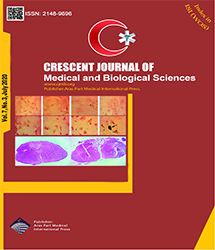| Original Article | |
| Comparison of 2 Methods of Acromioclavicular Joint Dislocation Fixation With Both Row Screw and Hook Plate | |
| Kamyar Aeinfar1, Ali Sadighi1, Hossein Aslani1 | |
| 1Department of Orthopedic, Tabriz Shohada Hospital, Tabriz University of Medical Sciences, Tabriz, Iran | |
|
CJMB 2020; 7: 389-392 Viewed : 4100 times Downloaded : 31341 times. Keywords : Acromioclavicular dislocation, Hook plate, Screw, Device failure, Range of motion |
|
| Full Text(PDF) | Related Articles | |
| Abstract | |
Objectives: Acromioclavicular joint (ACJ) dislocation is one of the most common shoulder injuries, especially in young and athletes, which has a significant effect on a patient"s function. Therapeutic strategies include non-surgical and a variety of surgical methods. Each of the 2 therapies has some advantages and disadvantages and careful decision making regarding the appropriate therapeutic approach in these patients has not been achieved due to controversial results. Standard surgical treatment is not specified as well. In this regard, the present study was conducted to compare both row screw and hook plate. Materials and Methods: In this retrospective cohort study, 68 patients were enrolled after referring to the Shohada Medical Education Center of Tabriz during 2014-2017 with the dislocation of the 4th, 5th, and 6th grade ACJ dislocation. In this study, 44 and 24 patients underwent open reduction and internal fixation with a screw and a hook plate, respectively. The retest workers, and the shoulder range of motion (ROM), as well as pain and device failure were compared between the 2 groups. Results: According to the results, there were no significant differences between 68 patients with acute dislocation of ACJ type 4, 5, and 6 in terms of work time and pain intensity in the 2 groups (P = 0.78 and P = 0.29), but in the examination of ROM, abduction, forward flexion, and external rotation had significantly higher limitations in hook plate compared to the screw (P = 0.03, P = 0.001, and P = 0.02). The maximum motion limitation was observed in shoulder abduction, but the internal rotation between the 2 groups was not significantly different. Eventually, the device failure rate for the screw was significantly higher and approximately 18.4% whereas there was no device failure in hook plate fixation. Conclusions: Based on the present results regarding acromioclavicular dislocation, surgical treatment using a screw showed better functional improvement in comparison to the hook plate although the probability of devise failure was higher. |
Cite By, Google Scholar
Online Submission System
 CJMB ENDNOTE ® Style
CJMB ENDNOTE ® Style
 Tutorials
Tutorials
 Publication Charge
Medical and Biological Research Center
About Journal
Publication Charge
Medical and Biological Research Center
About Journal
Aras Part Medical International Press Editor-in-Chief
Arash Khaki
Deputy Editor
Zafer Akan


















